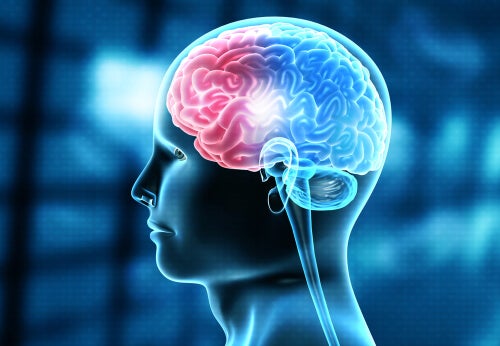Gerstmann's Syndrome: When You Can't Recognize Your Fingers

Gerstmann’s syndrome is a rare neurological disease. It’s best-known for its most prominent characteristic: the patient’s inability to recognize their own fingers. However, beyond this symptom, it’s a much more complex and acquired disease. This means that the symptoms appear after sustaining some form of injury or illness.
The condition was named after Josef Gerstmann, a young assistant at the Department of Neurology at the University of Vienna, Austria. This student described a series of symptoms in a woman who had suffered a stroke. From that moment on, the condition, composed of agraphia, digital agnosia, and acalculia, bore his name.

The causes of Gerstmann’s syndrome
First of all, we should note that most reported cases arose from a vascular problem. This seems to be the main cause of this syndrome, which is characterized by the inability to operate or recognize the fingers. Here are the most common symptoms of this condition:
- First of all, digital agnosia. The impossibility of recognizing the fingers. The patient acts as if they don’t have their fingers.
- Agraphia. In conjunction with the above symptom, these patients lose the ability to express themselves through writing.
- Acalculia. Patients with Gerstmann’s syndrome also lose the ability to perform simple arithmetic operations.
- Finally, disorientation. The inability to orient themselves correctly at a spatial level and confusing, or not recognizing, the distinction between left and right.
Acquired damage in Gerstmann’s syndrome
In 1930, Gerstmann finally finished describing the syndrome after studying his patients’ injuries. He found that most had damage in the dominant parietal lobe, more specifically the angular gyrus.
The Penfield homunculus, a somatosensory mapping of the body, is in the parietal lobe. Within the parietal lobe, there’s a specific area focused on the fingers. This area is much larger in proportion to the rest of the body, due to the importance and amount of nerve endings our hands have.
Angular rotation
This area, which is especially affected in Gerstmann’s syndrome, occupies the lower part of the parietal lobe. It’s related to language interpretation, which is the assignment of a common code for visual and auditory information.
Usually, patients with this syndrome have vascular injuries in the left middle cerebral artery, which irrigates the angular gyrus.
Clinical characteristics
Thus, we should clarify that Gerstmann’s syndrome often occurs in an incomplete fashion. This means that the three main symptoms don’t have to be present in order to make a diagnosis.
On many occasions, there’s no sign of agraphia. Instead, semantic aphasia is very common. This is a defect in the understanding of logico-grammatical structures.
Gerstmann’s syndrome today
Since the syndrome was described many years ago, scientific advances have debated many of its components. Scientists are currently discussing the organic foundation of the syndrome. They’re proposing other areas of the parietal lobe in the etiology of the syndrome.
Most patients show lesions in the left parietal lobe, the dominant hemisphere in most of the right-handed population. Therefore, abnormalities occur at a cortical level in areas of complex processing.
Diagnosis
The main disciplines that deal with the diagnosis of this syndrome are neurology and neuropsychology. Suspicions of this syndrome often become evident when affected patients have to do tasks that involve finger recognition.
From a neurological level, the diagnosis begins with exploratory tests. Then, doctors will confirm it using tomography or magnetic resonance imaging that allows them to see any damaged tissue. Likewise, neuropsychology is responsible for evaluating and then assessing impaired cognitive abilities through clinical observation.

Treatment
There are different treatments, according to each individual specialist. In short, a combined neurological and psychological approach is always necessary.
- Neurological treatment. The approach focuses on organic damage through standardized procedures. The treatment will then depend on whether the cause was vascular or due to a brain tumor.
- Neuropsychological treatment. This approach works on the cognitive functions affected by the injury. In addition to this, given the variability of symptoms, the treatment must be individualized and multidisciplinary.
- Psychoeducation. Information and awareness about the syndrome are very important in order to work on the underlying emotional aspects.
Finally, doctors and experts must focus both treatments on the patient’s functional recovery. Therefore, their goals must seek optimal functioning and discourage isolation.
In principle, although Gerstmann’s syndrome is rare among the general population, it has attracted the attention of researchers and specialists due to its characteristics.
The interest lies in the fact that correct brain functioning also depends on the correct functioning of the vascular system. Therefore, all the activities that imply a risk factor for the circulatory system will also be a danger for the nervous system.
This text is provided for informational purposes only and does not replace consultation with a professional. If in doubt, consult your specialist.








